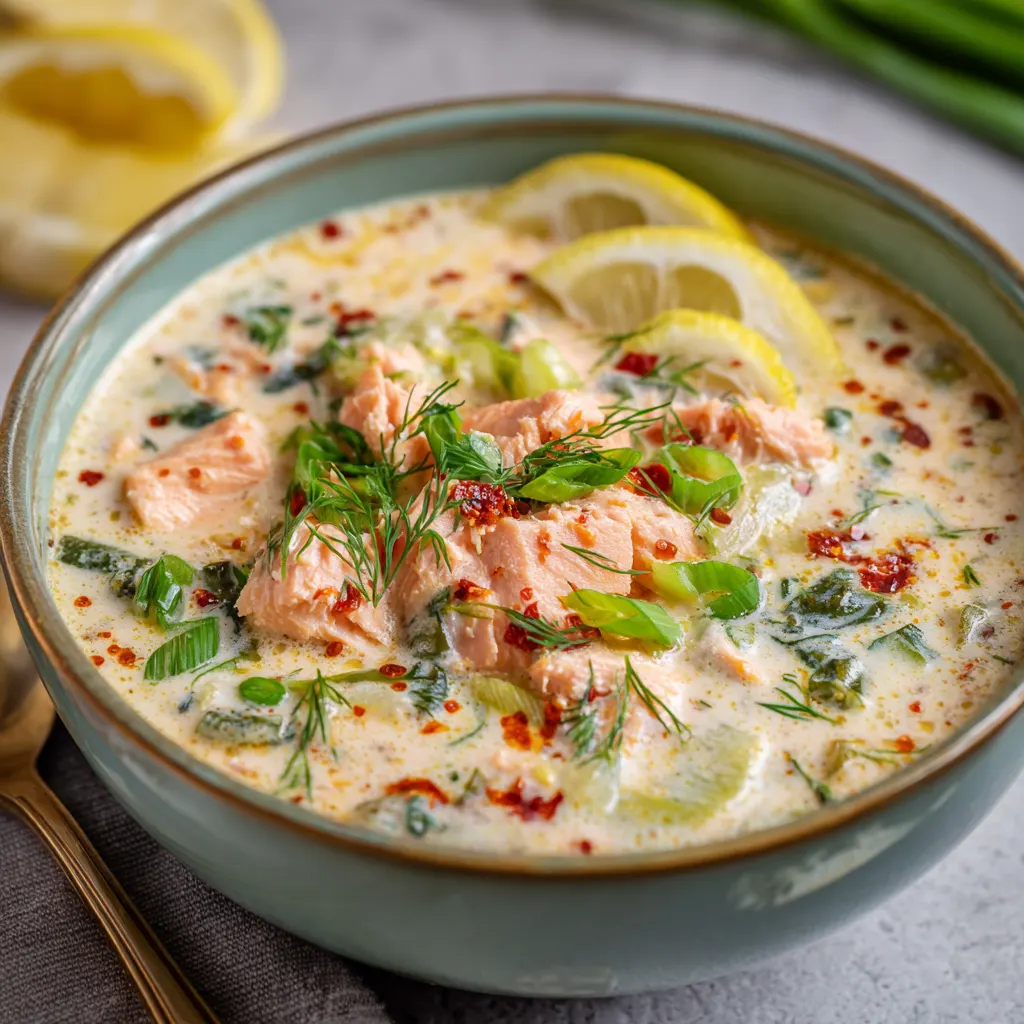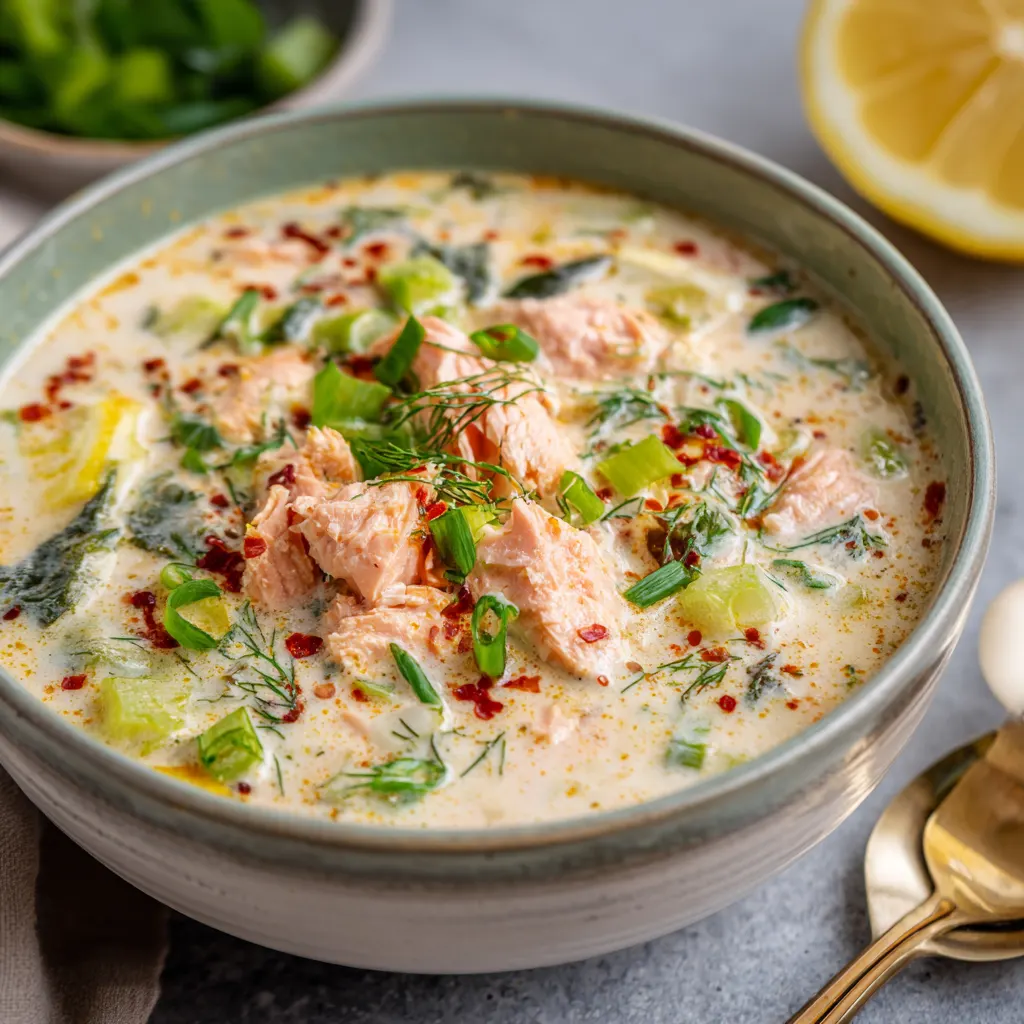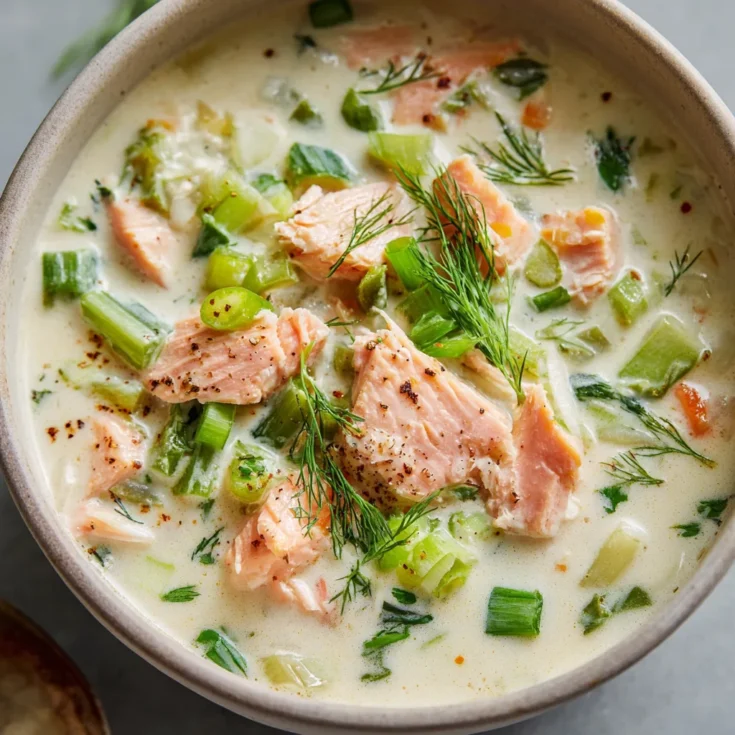There’s something soul-soothing about a bowl of creamy salmon soup. But when you can make it without turning on the oven, it becomes even more irresistible. This no bake version brings all the comfort—without the hassle.
Instead of traditional baked methods, this salmon soup is cooked entirely on the stovetop. That means faster prep, easier cleanup, and zero oven heat—perfect for busy evenings or warmer days. The process is straightforward: sauté, simmer, and stir in the cream. You get the same depth of flavor, all from a single pot.
This creamy salmon soup isn’t just quick—it’s also nourishing and satisfying. Salmon provides high-quality protein and omega-3s. Add in fresh vegetables and a rich, velvety broth, and you have a well-balanced dish that feels indulgent without being heavy. Plus, it’s customizable. Whether you’re going gluten-free or dairy-free, this soup adapts beautifully.
In this article, you’ll learn everything you need to make this no bake creamy salmon soup a staple in your kitchen. We’ll explore its origin, break down the key ingredients, and walk you through the step-by-step process for making it at home. You’ll also get serving ideas, storage tips, and answers to common questions. And to wrap it all up, you’ll find a ready-to-use recipe card with complete nutritional guidance and prep details.
Whether you’re new to stovetop soups or a seasoned home cook, this guide is packed with tips and tricks to help you master the dish from start to finish. Let’s dive in.
What Is Creamy Salmon Soup?
Origins and Variations of Creamy Salmon Soup
Creamy salmon soup has deep roots in Nordic cuisine, especially in Finland and Norway. In Finland, it’s known as Lohikeitto—a traditional dish made with fresh salmon, leeks, potatoes, and dill. The base is typically a light fish broth enriched with cream or milk, creating a comforting and mild flavor. Similarly, Norwegian fiskesuppe incorporates a creamy base and features root vegetables, fresh herbs, and delicate chunks of fish. Both versions focus on simplicity, letting the natural flavor of the salmon shine through.
Across Northern Europe, these soups are more than just meals—they’re cultural staples, often passed down through generations. Their minimal ingredients, wholesome nature, and cozy flavors make them ideal for colder climates. These versions have inspired countless interpretations worldwide, each adding its own regional flair while staying true to the soul-warming essence of creamy fish soup.
American-Style Salmon Chowders and Bisque Variations
In the United States, creamy salmon soup has evolved into something bolder and richer. American-style salmon chowders typically include chunks of potato, carrots, celery, and onion. The broth is thick and luxurious, made creamy with milk, half-and-half, or heavy cream. Some versions introduce sweet corn, spices, and smoked paprika for added depth and color.
Salmon bisques, though smoother in texture, share the same core ingredients. These are often pureed for a velvety consistency and flavored with seafood stock, butter, and sometimes saffron. While Scandinavian versions focus on freshness and lightness, American interpretations lean into richness and heartiness. Despite their differences, both styles deliver a deeply satisfying bowl of comfort and are popular choices for chilly days or indulgent dinners.
What “No Bake” Means in This Recipe
Traditional creamy soups may require oven time—especially when slow-roasting ingredients or baking the entire dish. In contrast, no bake creamy salmon soup uses a stovetop or single skillet method. You sauté vegetables, simmer the stock, and gently cook the salmon—all without using the oven. This approach streamlines the cooking process while preserving flavor.
Why Choose a No Bake Method
The stovetop method offers speed and simplicity. It’s easier to manage, involves fewer dishes, and takes less time overall. You can whip up a nourishing meal without preheating or waiting—ideal for weeknight dinners or small-batch cooking.
Nutritional Highlights of Creamy Salmon Soup
Salmon is a powerhouse ingredient—rich in omega‑3 fatty acids, protein, and essential nutrients. Combined with cream and vegetables, this soup offers both comfort and nutrition. The healthy fats support brain and heart health, while the vegetables provide fiber and essential vitamins.
Dietary adaptations are easy, too. You can make it gluten-free by skipping flour thickeners. For a dairy-free version, swap cream with coconut milk or plant-based alternatives. This flexibility makes the soup suitable for various diets without sacrificing its creamy, satisfying character.
Core Ingredients & Their Roles
Salmon: The Heart of the Soup
Salmon is the star of this creamy soup. Both wild-caught and farm-raised varieties work well, though wild salmon offers a richer flavor and firmer texture. Its natural fat content enhances the creaminess, making each bite melt-in-your-mouth tender. When possible, choose skin-on salmon. The skin can be simmered with aromatics to create a quick, flavorful fish stock—perfect as a soup base. Whether you cube it or shred it after cooking, salmon provides high-quality protein, omega‑3s, and a hearty richness that elevates this dish.
Vegetables and Aromatics: Building the Base
Every spoonful of creamy salmon soup should deliver layers of flavor, and vegetables play a key role. Potatoes add body and make the soup more filling, while leeks or onions provide subtle sweetness and depth. Carrots contribute color and natural sugars, balancing the richness of the cream. Garlic brings warmth and complexity without overpowering. Together, these ingredients soften beautifully as they simmer, creating a silky texture that complements the tender salmon. They’re simple but essential—each playing a specific role in taste and mouthfeel.
Liquid Base and Dairy: Crafting Creamy Comfort
The soup begins with a flavorful liquid base. Traditional recipes often use fish stock, especially when salmon skin or bones are available. However, vegetable broth or chicken stock can easily substitute, especially for convenience or dietary needs. The goal is a light but savory broth that supports the cream and fish.
Dairy brings richness. Heavy cream yields a thick, luxurious texture, while half-and-half gives a lighter finish. For dairy-free versions, full-fat coconut milk provides a creamy feel with a slight tropical twist. Each option delivers comfort while offering flexibility for various dietary needs.
Seasonings and Flavoring Agents: Bright and Balanced
The flavor of creamy salmon soup is enhanced with a handful of aromatic additions. Fresh dill is essential—it’s traditional in Nordic recipes and adds a clean, herbaceous lift. Allspice introduces subtle warmth and pairs beautifully with the creamy base. A bay leaf simmers in the broth to deepen the background flavor.
For added brightness, a splash of lemon juice or a few lemon zest shavings do wonders. They cut through the richness and amplify the salmon’s natural taste. Though traditional recipes may call for white wine or saffron, you can skip alcohol entirely and still enjoy a deeply flavorful dish. Use a pinch of saffron or turmeric for color and complexity if desired. These seasoning choices help balance creaminess with freshness, ensuring that each spoonful is rich—but never heavy.
Step-by-Step No Bake Method
Prep Work: Setting the Foundation
Before you start cooking, take a few moments to prep your ingredients. Rinse the leeks thoroughly to remove hidden grit between the layers. Slice them into thin rounds. Peel and dice the potatoes and carrots into even chunks so they cook at the same rate. Mince the garlic finely for even flavor distribution.
If you’re working with a whole salmon fillet, remove the skin carefully and set it aside. Check for any bones and remove them with kitchen tweezers. Then cut the salmon into bite-sized cubes. This step ensures tenderness and helps the fish cook quickly and evenly in the soup.
You can also take a few minutes to prep a quick fish stock using the salmon skin and bones. This extra effort brings a deeper flavor to the broth and makes use of every part of the fish.
Fish Stock (Optional but Flavorful)
Making homemade fish stock is simple and adds richness to your soup. Place the reserved salmon skin and bones into a small saucepan. Add water, one bay leaf, a few peppercorns, and a couple of slices of leek or onion. Simmer gently for about 15–20 minutes.
Avoid boiling, as this can turn the stock cloudy or bitter. Once done, strain it through a fine mesh sieve and discard the solids. You’ll be left with a golden, flavorful broth that enhances the taste of the final soup. If short on time, skip this step and use a quality store-bought fish or vegetable broth.
Cooking Process: From Base to Bowl
Start by heating butter or olive oil in a large saucepan over medium heat. Add the sliced leeks, carrots, and garlic. Sauté gently until the leeks are soft and fragrant, about 5–7 minutes. Stir often to prevent browning. The aroma should be warm and slightly sweet.
Next, add the diced potatoes and your prepared broth or stock. Bring to a gentle simmer and cover. Cook for 10–12 minutes or until the potatoes are tender when pierced with a fork. Don’t overcook—they should hold their shape in the final soup.
Lower the heat and pour in the cream or your chosen dairy substitute. Stir to combine. Add the cubed salmon and continue to simmer gently for 5–7 minutes, or until the fish turns opaque and flakes easily. Stir occasionally but gently to avoid breaking up the salmon too much.
Finish the soup by seasoning with salt, pepper, a pinch of allspice, and fresh dill. Add a splash of lemon juice for brightness. Taste and adjust the seasoning as needed. The flavors should feel balanced—creamy, herby, and vibrant, with a soft hint of sweetness from the vegetables.
Variations and Troubleshooting
Want a dairy-free version? Swap out the cream for full-fat coconut milk. It keeps the soup luscious with a slightly sweet twist. For added richness, use a spoonful of plant-based butter during the sauté step.
Prefer a bisque-like texture? Puree half of the soup with an immersion blender, then stir in the salmon and cook until tender. This gives a velvety feel while keeping the fish pieces whole and satisfying.
For added flair, top your soup with crispy salmon skin or seared salmon chunks. They add texture and contrast to the creamy base.
Need to thicken the soup? Mix a tablespoon of cornstarch with cold broth or water, then stir it in during the simmer. It gives you a silky finish without changing the flavor. If the soup tastes bland, a squeeze of lemon or a dash of salt often does the trick.





